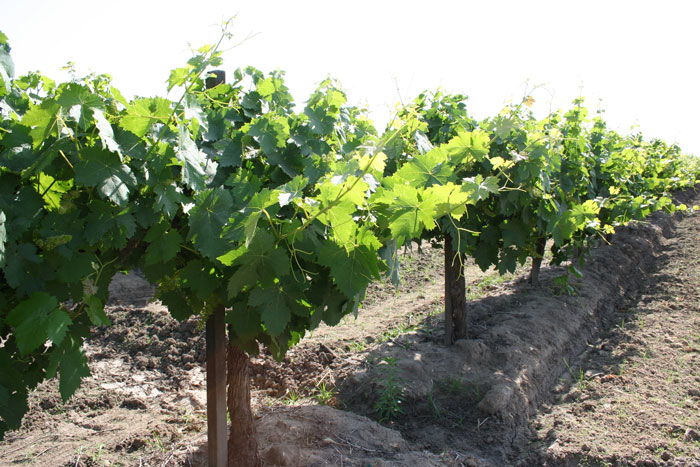
Although grape vines thrive under conditions of warm, dry days and cool nights, vine growth and fruit quality begin to suffer once the thermometer rises past the 95-degree mark. That’s when metabolic processes start to decline, says Ashraf El-Kereamy, University of California Cooperative Extension viticulture farm advisor for Kern County.
Vines can recover from the stress of moderately high temperatures, which can impair chlorophyll production. But exposure to higher temperatures for an extended time can cause significant and permanent damage. This includes a drop in chlorophyll levels and sugar content. Energy supplies also decline, affecting growth of shoots and fruit.
That’s not all. As El-kereamy explains in the spring issue of Vit Tips, the San Joaquin Valley Viticulture Newsletter, high temperatures may disrupt cell function and lead to death of the cells.
“Heat stress disrupts the uptake and translocation of water, nutrients, and organic compounds across the plant membranes and negatively affects photosynthesis and respiration,” he says. “Heat stress reduces leaf osmotic potential, which leads to stomatal closure and reduces tissue water content. Vines respond to heat stress by producing protective proteins and other components, such as amino acids, which mitigate the negative effect of protein denaturation and production of the free radical, Reactive Oxygen Species (ROS).”
The effects of elevated temperatures depend on the phenological stage of the vine, he notes. For example, exposure to high temperatures early in the season can reduce leaf or berry size and cause shriveling of shoots. At bloom, heat stress can lead to excessive shatter, which affects cluster fullness or reduces the number of berries per cluster.
After fruit set, excessive temperatures can inhibit growth of the small berries and may cause scarring and/or cracking. The impact of hot weather may extend beyond the heat wave, especially if photosynthesis has been impaired, El-Kereamy says
High temperature can slow berry ripening by reducing photosynthesis and/or altering the structure of proteins in tissues exposed to direct sunlight, he reports. This prevents fruit tissues from developing normal color. In red varieties, for example, anthocyanin biosynthesis is hindered, while green varieties develop an amber color.
“During berry ripening, high temperature-induced reductions in sugar accumulation can be attributed to a sustained reduction in photosynthesis over several days after the exposure to high temperatures,” El-Kereamy says.
Some of these responses are due to the production of the free radical, Reactive Oxygen Species (ROS), which reacts and damages the cell pigments and structure, he adds.
“Similar physiological responses are associated with vine dehydration under drought stress,” El-Kereamy says. “The ROS react and negatively affect several cell components, resulting in decreased vine growth and fruit quality.”
Different grape varieties vary in their ability to tolerate high temperatures. This may reflect differences in their physiological or morphological structure, he notes. For example, varieties with a weak canopy tend to have more problems under heat stress compared to more vigorous varieties.
Understanding how heat stress affects the vines can help reduce the impact of high temperatures, say El-Kereamy. He offers the following tips for managing vineyards during a summer heat wave:
Develop a good canopy early in the season by providing a good nutrition and irrigation program.
Watch for expected heat waves.
Closely monitor vineyard water status and avoid a water shortage during and after heat stress.
Develop good canopy management practices to protect clusters from direct sunlight.
Rethink shoot thinning or hedging if heat waves are expected.
Consider using cultural practices or foliar sprays that increase vine amino acid content.
Watch for pests and diseases after any heat waves that may take a few days to be observed.
About the Author(s)
You May Also Like




